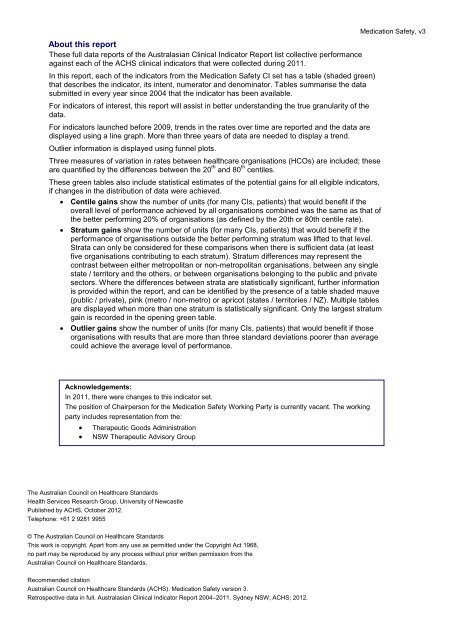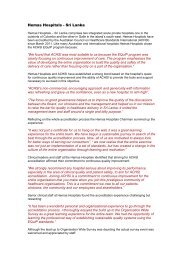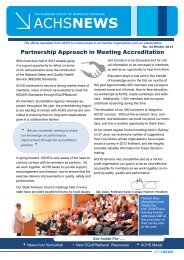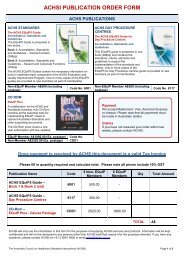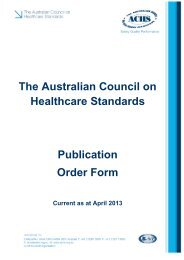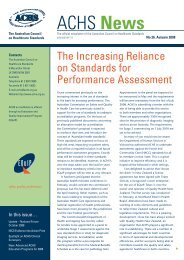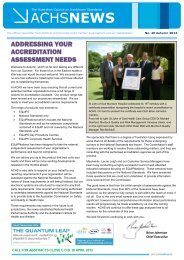Download (1.19 MB) - Australian Council on Healthcare Standards
Download (1.19 MB) - Australian Council on Healthcare Standards
Download (1.19 MB) - Australian Council on Healthcare Standards
Create successful ePaper yourself
Turn your PDF publications into a flip-book with our unique Google optimized e-Paper software.
About this report<br />
These full data reports of the Australasian Clinical Indicator Report list collective performance<br />
against each of the ACHS clinical indicators that were collected during 2011.<br />
In this report, each of the indicators from the Medicati<strong>on</strong> Safety CI set has a table (shaded green)<br />
that describes the indicator, its intent, numerator and denominator. Tables summarise the data<br />
submitted in every year since 2004 that the indicator has been available.<br />
For indicators of interest, this report will assist in better understanding the true granularity of the<br />
data.<br />
For indicators launched before 2009, trends in the rates over time are reported and the data are<br />
displayed using a line graph. More than three years of data are needed to display a trend.<br />
Outlier informati<strong>on</strong> is displayed using funnel plots.<br />
Three measures of variati<strong>on</strong> in rates between healthcare organisati<strong>on</strong>s (HCOs) are included; these<br />
are quantified by the differences between the 20 th and 80 th centiles.<br />
These green tables also include statistical estimates of the potential gains for all eligible indicators,<br />
if changes in the distributi<strong>on</strong> of data were achieved.<br />
Centile gains show the number of units (for many CIs, patients) that would benefit if the<br />
overall level of performance achieved by all organisati<strong>on</strong>s combined was the same as that of<br />
the better performing 20% of organisati<strong>on</strong>s (as defined by the 20th or 80th centile rate).<br />
Stratum gains show the number of units (for many CIs, patients) that would benefit if the<br />
performance of organisati<strong>on</strong>s outside the better performing stratum was lifted to that level.<br />
Strata can <strong>on</strong>ly be c<strong>on</strong>sidered for these comparis<strong>on</strong>s when there is sufficient data (at least<br />
five organisati<strong>on</strong>s c<strong>on</strong>tributing to each stratum). Stratum differences may represent the<br />
c<strong>on</strong>trast between either metropolitan or n<strong>on</strong>-metropolitan organisati<strong>on</strong>s, between any single<br />
state / territory and the others, or between organisati<strong>on</strong>s bel<strong>on</strong>ging to the public and private<br />
sectors. Where the differences between strata are statistically significant, further informati<strong>on</strong><br />
is provided within the report, and can be identified by the presence of a table shaded mauve<br />
(public / private), pink (metro / n<strong>on</strong>-metro) or apricot (states / territories / NZ). Multiple tables<br />
are displayed when more than <strong>on</strong>e stratum is statistically significant. Only the largest stratum<br />
gain is recorded in the opening green table.<br />
Outlier gains show the number of units (for many CIs, patients) that would benefit if those<br />
organisati<strong>on</strong>s with results that are more than three standard deviati<strong>on</strong>s poorer than average<br />
could achieve the average level of performance.<br />
Medi Medicati<strong>on</strong> Safety, v3<br />
Acknowledgements:<br />
In 2011, there were changes to this indicator set.<br />
The positi<strong>on</strong> of Chairpers<strong>on</strong> for the Medicati<strong>on</strong> Safety Working Party is currently vacant. The working<br />
party includes representati<strong>on</strong> from the:<br />
<br />
<br />
Therapeutic Goods Administrati<strong>on</strong><br />
NSW Therapeutic Advisory Group<br />
The <str<strong>on</strong>g>Australian</str<strong>on</strong>g> <str<strong>on</strong>g>Council</str<strong>on</strong>g> <strong>on</strong> <strong>Healthcare</strong> <strong>Standards</strong><br />
Health Services Research Group, University of Newcastle<br />
Published by ACHS, October 2012.<br />
Teleph<strong>on</strong>e: +61 2 9281 9955<br />
© The <str<strong>on</strong>g>Australian</str<strong>on</strong>g> <str<strong>on</strong>g>Council</str<strong>on</strong>g> <strong>on</strong> <strong>Healthcare</strong> <strong>Standards</strong><br />
This work is copyright. Apart from any use as permitted under the Copyright Act 1968,<br />
no part may be reproduced by any process without prior written permissi<strong>on</strong> from the<br />
<str<strong>on</strong>g>Australian</str<strong>on</strong>g> <str<strong>on</strong>g>Council</str<strong>on</strong>g> <strong>on</strong> <strong>Healthcare</strong> <strong>Standards</strong>.<br />
Recommended citati<strong>on</strong><br />
<str<strong>on</strong>g>Australian</str<strong>on</strong>g> <str<strong>on</strong>g>Council</str<strong>on</strong>g> <strong>on</strong> <strong>Healthcare</strong> <strong>Standards</strong> (ACHS). Medicati<strong>on</strong> Safety versi<strong>on</strong> 3.<br />
Retrospective data in full. Australasian Clinical Indicator Report 2004–2011. Sydney NSW; ACHS; 2012.


